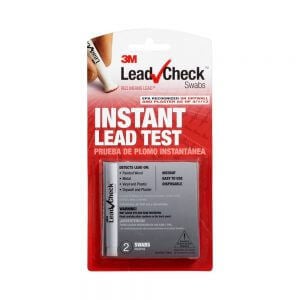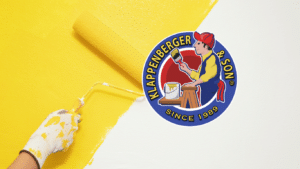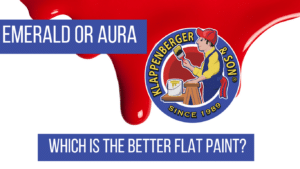What To Do About Lead-Based Paint In Older Homes
Older homes and buildings might be full of charm, but they often have a secret inside: lead-based paint. Knowing what to about this mineral in paint is a serious concern if there is chipping.

Lead-based paint isn’t always a cause for concern. If the paint job is still in good condition, there’s little to worry about. Once the paint begins to chip, it becomes a health hazard and needs to be corrected sooner rather than later.
What Is Lead-Based Paint?
Any paint containing lead is known as lead-based paint or Pb. Up until the late 1970s, it was commonly used on both the interior and exterior of homes.
Lead is a type of metal, with the chemical symbol Pb. It has some special qualities that have made it a useful material and continue to make it a useful material for a variety of purposes. It has been a common additive in the paint for thousands of years. Pb is a unique metal that helps make the paint more durable and moisture-resistant and even helps it dry faster.
Why Is Lead Paint (Pb) Dangerous?

Lead paint is still used for some applications, but the large amounts of it used to be common in interior and exterior home paint are no longer allowed. When a person is exposed to lead, either through contact with their skin, breathing it in, or ingesting it, this exposure can cause some serious health problems. The worst cases can be fatal. Some of the symptoms of short-term exposure include:
- Headaches

- Constipation
- Feeling tired or fatigued
- Appetite loss
- Memory loss
- Irritableness
- Weakness
Pregnancies, Women and Children Are Most Vulnerable To Lead Paint
Children are especially vulnerable to the dangers of Pb. Those between the ages of 6 months and 6 years are the most vulnerable. A child is likely to display symptoms after being exposed to a smaller amount of lead than an adult. Children can be exposed to lead from dust, or attached on the cloths of others who were exposed to it. Children start to demonstrate signs of its toxicity, such as brain damage and anemia, after exposure to even small amounts.
Other people who are more vulnerable to damage from lead paint include menopausal and post-menopausal women and pregnant women. Pb can cross the placental barrier in a pregnant woman, harming the fetus. There is a risk of miscarriage or stillbirth if a pregnant woman is exposed to certain levels of lead.
The most common cause of lead exposure is lead dust inhalation. According to the Centers for Disease Control (CDC), more of this mineral is absorbed by the body when it’s inhaled compared to other methods of exposure, such as ingestion. Once in the body, it is often stored in the bones, blood, and other tissues. It is stored in the body can provide a continual source of exposure over the years. As people age and their bones become weaker, more lead can be released into the body. This is one reason why menopausal women often have higher levels of lead than other women.
Generally speaking, though, the health risks are considerably lower in adults than in children.
How Do You Know If There Is Pb in Your House?
Although Pb paint is not found in homes built after 1978, it could be in homes built before 1978. Usually, the older the house, the higher the chance. About 87% of homes built before 1940 had contained Pb while about 69% of homes built between 1940 and 1959 had it. About one-quarter of homes built in the 1960s and 1970s contain Pb.

Lead test kits can be purchases at all paint stores. Or, if you prefer you can hire a lead inspection. Klappenebreger & Son can check for the lead as well although we are not authorized to certify that your home is lead-free.
How Do You Identify Paint With Lead?
Pb paint is hard to spot just by looking, though there is one visual indication that can tip you off to the presence of lead. As the paint ages, it will chip in a way that looks like reptile scales. If an old layer of lead paint is covered with fresh layers of paint that doesn’t contain lead, you likely won’t see the scaly look.
The National Association of REALTORS® recommends looking in areas that are less likely to be covered in fresh paint, such as closets and basement window sashes, to see if you may have lead-based paint in your home or a home you’re looking at buying or renting. Even if you see what looks like it could be positive for the harmful mineral, the only surefire way to identify it is with an inspection. You can purchase a lead testing kit at your local hardware store, but this is only useful for testing the top layer of paint on surfaces in your home.
A Professional Lead Inspection
A professional inspection is necessary for more thorough results. The most rigorous type of inspection entails testing the paint throughout your house either by using a portable x-ray machine or sending samples off to an accredited lab. If the inspector uses an x-ray machine, they should be able to leave your paint intact unless the results are inconclusive, in which case, they’ll need to take samples to send to a lab.
You can also get a risk assessment inspection. This inspection focuses solely on suspect areas of deteriorating paint in your home such as windows, handrails. It is aimed at letting you know whether there are any hazards from lead you need to remedy. A hazard screen is a third option that’s suitable for homes that are at low risk for containing lead paint. This type of inspection will give you an idea of whether you need to take further steps to look for lead paint.
What Should You Do About Lead-Based Paint?

All this information about the dangers of Pb paint and its prevalence can be cause for concern, but the good news is that lead paint typically does not cause a problem unless it is chipping and flaking off or is sanded. Disturbing lead paint can release small particles, which can combine with other household dust and be inhaled.
Here are a few steps you should take to reduce your exposure to lead dust:
- Watch for deteriorating paint: The Environmental Protection Agency (EPA) recommends you maintain your house and minimize risks by keeping an eye out for deteriorating paint. If you spot flaking or chipping lead paint, you need to act quickly to remove the hazard. Remember that only a professional should handle the remediation and removal of lead-based paint. There are fines of around $30,000 for improper lead remediation.
- Remove deteriorating paint: Chipping or peeling lead paint must be addressed quickly to reduce the risk of lead poisoning. This will likely involve sanding the area down and repainting, which you should hire a professional to do if you suspect the paint chips contain lead.
- Keep your home clean: Whether you see deteriorating paint or not, you should wipe down flat surfaces like window sills and mop your floors at least weekly to keep them free of dust. Although lead-based paint can be a source of dust, it is also possible to track lead-in from the soil outside or from other exterior surfaces that are contaminated with lead.
- Have your home painted: Have your house painted. This will encapsulate the lead paint. Then just keep an eye on any future areas for chipping.
What Should You Do When Moving Into a House With Lead Paint?

Every day, people move into older homes. Older houses often have a historic charm or unique features. They can be more affordable than new construction. Whatever your reason for choosing an older home, there is a chance it contains some Pb. To play it safe, or if you notice any areas where the paint is wearing away, you may want to get the house tested. If a test reveals the presence of Pb, your landlord needs to take action to remediate it immediately. In some cases, you might decide to look for a different home.
If you’re moving into a house that contains Pb, you’ll want to take note of any potential areas that could prove hazardous. Did you have a risk assessment or inspection that revealed certain areas or surfaces present more of a hazard than others? Do you see any paint that appears scaly? If all the old lead paint in your house has been covered over with new paint, then you shouldn’t have much to worry about. Covering old paint with new is known as encapsulation.
Renovation Projects and Lead Paint
However, if you plan any renovation projects, you should be concerned about creating lead dust. There are certain protocols and requirements that must be adhered to. A little dust from replacing windows that have lead paint can permanently affect children. Any sanding or demo work that conjures dust and paint chips needs to be cleaned and properly removed.
Can a Homeowner Remove Lead Paint?
We do not recommend trying to remove Pb paint on your own, even if it is legal to do so in your state.
How dangerous is it to remove? The short answer is “very.” Removing harmful paint can cause flakes and particles of paint to become airborne and land on surfaces in your home. Considering how hazardous it is, this is not a task you want to attempt without the right equipment and expertise. You’re far better off hiring a certified lead abatement contractor who can carefully remove the lead paint.
Lead paint removal isn’t the same as an average paint job. During the process, we need to wear special white jumpsuits, respirators, and gloves. We have to put up signs and distribute pamphlets to let the neighbors know about the project and the risks. Then we must cover the area being treated in plastic and roll up that plastic at the end of the day in a particular way to reduce the spread of lead dust. We then need to dispose of the plastic properly.
These extra precautions reduce the risk of spreading lead exposure.
What Is the Best Way to Remove Lead Paint?

The best way to remove paint with Pb is to hire a professional contractor who has the necessary experience and certification to handle the job. Klappenberger & Son is certified to encapsulate or remove it.
Although you won’t have to worry about how to remove the paint yourself when you hire a professional, it can be helpful to understand some of the approaches your contractor may use.
They may try wire brushing, wet hand scraping with liquid paint removers or hand scraping with a low-temperature heat gun. Any sanding of lead paint should be done with a (HEPA) filtered vacuum to contain the dust. They will also use an encapsulating primer to seal the surface and prevent lead dust from getting into the air.
It may be even more helpful to know what methods a contractor should not use. Lead dust must be contained and encapsulated. A trained contractor does not use a method that allows dust to be kicked up into the air. They shouldn’t scrape dry paint or sand without a HEPA filter vacuum cleaner. You also shouldn’t see them sandblast or open-flame burning.
What Other Abatement Methods Are There Besides Removal?

Removal isn’t the only abatement method. There are three other approaches you can take to keep you and your family safe from lead paint in your home. These methods include:
- Encapsulation: There are products designed to cover Pb paint, effectively sealing it off. These products look like paint, but they have special properties to help them create a watertight bond. Just covering over this toxic mineral with paint that doesn’t contain lead can help, but an encapsulant product is a more effective option.
- Enclosure: Another option is an enclosure, which is similar to encapsulation, as it covers the lead paint surface. Enclosure means the painted surface is covered with a whole new material. It could be a type of cladding or even new drywall. Enclosing lead paint surfaces can be an effective abatement method, though the lead paint could still cause problems if you ever renovate in the future.
- Replacement: Replacement is a more drastic measure you can take to get rid of lead hazards in your home. It can be a good approach if the lead paint is on doors, window sashes and sills, and other trim work you can remove. Once the material with lead paint is gone, you can install new lead-free doors and trim work.
Can You Paint Over Pb Paint?

You can paint over lead paint. If you decide to do so, it’s best to use a product intended for encapsulation and not just any type of paint. It’s also important to consider the condition of the lead paint before trying to cover it with paint or encapsulant products.
If the paint is chipping, bubbling, peeling or otherwise deteriorating, you should not try to paint over it. For one, your new paint job will look bumpy and uneven. More concerning, though, is the fact that you won’t effectively seal off the lead paint. In these cases, the best option is to hire a professional to remove the Pb paint, or sand away the deteriorating spots, before painting or using an encapsulant.
What Should You Do If You Accidentally Sanded Pb Paint?

You might start a painting project and only realize once you’re knee-deep that you are dealing with paint that has lead. Although sanding it without the proper protective measures in place is a dangerous scenario you want to avoid, it can happen.
If that happens, your best bet is to mitigate any further risk of lead exposure. Use a vacuum equipped with a HEPA-rated filter to vacuum up any dust that has settled in the area and run an air purifier to remove dust from the air. Discard any of the clothing and equipment you were wearing, as it may have lead on it. This is a good time to call in the professionals to assess the situation and determine the best way forward so you can stay safe.
Can You Sell a House With Lead Paint?

Selling a house with lead paint is a common occurrence and doesn’t require much extra work. You do not have to have your house tested to confirm whether or not there is lead paint present. The regulations in place apply to selling any home that was built before 1978. As the seller, you are required to provide the buyer with a few things, including:
- A disclosure of anything you know about the presence of lead paint in the house. If you aren’t aware of any, then that’s what you’ll communicate to the buyer.
- A pamphlet from the EPA. The pamphlet will educate buyers on some of the risks of lead and solutions they should be aware of.
- There is a 10-day period where a buyer has the opportunity to inspect the home for the presence of Pb.
- Why? So they can learn more about lead paint and can still back out of the sale.
- A Property Transfer Lead Paint Notification, which is a document all parties involved in the sale sign. This document demonstrates that they’re aware of the laws concerning lead paint.
Your house will sell easier if it is shown to be lead-free. Some buyers may shy away from older homes, because of the threat of lead paint. Keep in mind that any lead testing results you have, regardless of the results, must be shared with buyers.
Historic Preservation and Painting Services From Klappenberger & Son

If you’re looking to revitalize or restore a building that containsPb paint, Klappenberger & Son can help you do so safely and effectively. Not properly removing or remediating Pb can lead to hefty fines. These fines can be levied on homeowners and painting pros alike. A contractor experienced, licensed, and certified to remove lead paint will give you peace of mind.
With a wealth of experience in painting and historical restoration, we have the expertise to handle even the most challenging projects. Contact us today to learn more about how we can provide quality painting services for your next project. Pb







